Note
Click here to download the full example code
Visualize source time courses (stcs)¶
This tutorial focuses on visualization of stcs.
Table of Contents
Surface Source Estimates¶
First, we get the paths for the evoked data and the time courses (stcs).
import os
import os.path as op
import numpy as np
import matplotlib.pyplot as plt
import mne
from mne.datasets import sample
from mne.minimum_norm import apply_inverse, read_inverse_operator
from mne import read_evokeds
data_path = sample.data_path()
sample_dir = os.path.join(data_path, 'MEG', 'sample')
subjects_dir = os.path.join(data_path, 'subjects')
fname_evoked = data_path + '/MEG/sample/sample_audvis-ave.fif'
fname_stc = os.path.join(sample_dir, 'sample_audvis-meg')
Then, we read the stc from file
stc = mne.read_source_estimate(fname_stc, subject='sample')
This is a SourceEstimate object
print(stc)
Out:
<SourceEstimate | 7498 vertices, subject : sample, tmin : 0.0 (ms), tmax : 240.0 (ms), tstep : 10.0 (ms), data shape : (7498, 25), ~791 kB>
The SourceEstimate object is in fact a surface source estimate. MNE also supports volume-based source estimates but more on that later.
We can plot the source estimate using the
stc.plot just as in other MNE
objects. Note that for this visualization to work, you must have mayavi
and pysurfer installed on your machine.
initial_time = 0.1
brain = stc.plot(subjects_dir=subjects_dir, initial_time=initial_time,
clim=dict(kind='value', lims=[3, 6, 9]))
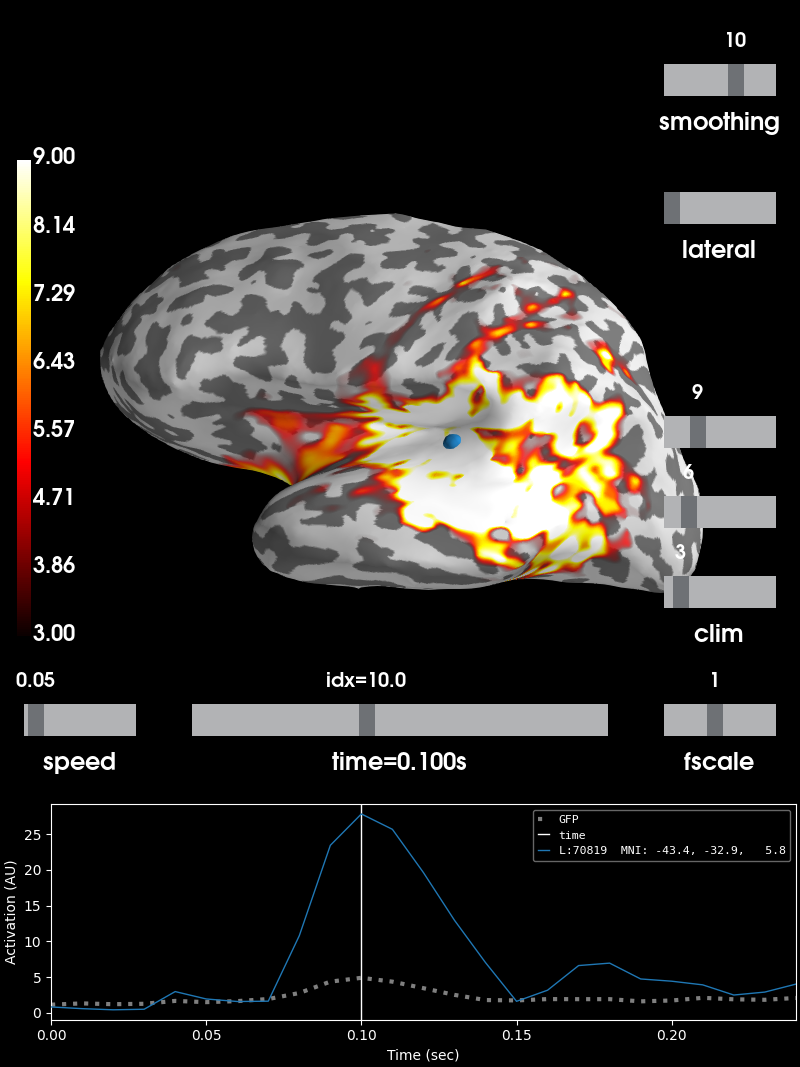
You can also morph it to fsaverage and visualize it using a flatmap:
stc_fs = mne.compute_source_morph(stc, 'sample', 'fsaverage', subjects_dir,
smooth=5, verbose='error').apply(stc)
brain = stc_fs.plot(subjects_dir=subjects_dir, initial_time=initial_time,
clim=dict(kind='value', lims=[3, 6, 9]),
surface='flat', hemi='split', size=(1000, 500),
smoothing_steps=5, time_viewer=False,
add_data_kwargs=dict(
colorbar_kwargs=dict(label_font_size=10)))
# You can save a movie like the one on our documentation website with:
# brain.save_movie(time_dilation=20, tmin=0.05, tmax=0.16,
# interpolation='linear', framerate=10)
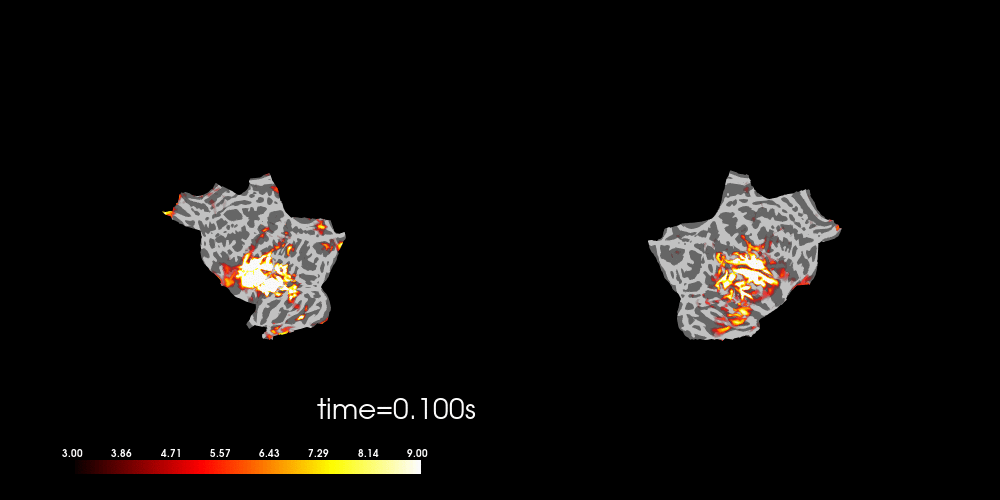
Note that here we used initial_time=0.1, but we can also browse through
time using time_viewer=True.
In case mayavi is not available, we also offer a matplotlib
backend. Here we use verbose=’error’ to ignore a warning that not all
vertices were used in plotting.
mpl_fig = stc.plot(subjects_dir=subjects_dir, initial_time=initial_time,
backend='matplotlib', verbose='error')
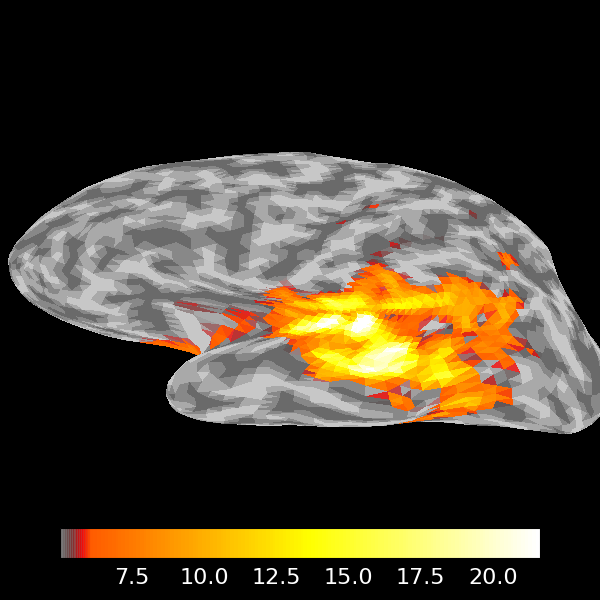
Volume Source Estimates¶
We can also visualize volume source estimates (used for deep structures).
Let us load the sensor-level evoked data. We select the MEG channels to keep things simple.
evoked = read_evokeds(fname_evoked, condition=0, baseline=(None, 0))
evoked.pick_types(meg=True, eeg=False).crop(0.05, 0.15)
# this risks aliasing, but these data are very smooth
evoked.decimate(10, verbose='error')
Out:
Reading /home/circleci/mne_data/MNE-sample-data/MEG/sample/sample_audvis-ave.fif ...
Read a total of 4 projection items:
PCA-v1 (1 x 102) active
PCA-v2 (1 x 102) active
PCA-v3 (1 x 102) active
Average EEG reference (1 x 60) active
Found the data of interest:
t = -199.80 ... 499.49 ms (Left Auditory)
0 CTF compensation matrices available
nave = 55 - aspect type = 100
Projections have already been applied. Setting proj attribute to True.
Applying baseline correction (mode: mean)
Removing projector <Projection | Average EEG reference, active : True, n_channels : 60>
Then, we can load the precomputed inverse operator from a file.
Out:
Reading inverse operator decomposition from /home/circleci/mne_data/MNE-sample-data/MEG/sample/sample_audvis-meg-vol-7-meg-inv.fif...
Reading inverse operator info...
[done]
Reading inverse operator decomposition...
[done]
305 x 305 full covariance (kind = 1) found.
Read a total of 4 projection items:
PCA-v1 (1 x 102) active
PCA-v2 (1 x 102) active
PCA-v3 (1 x 102) active
Average EEG reference (1 x 60) active
Noise covariance matrix read.
11271 x 11271 diagonal covariance (kind = 2) found.
Source covariance matrix read.
Did not find the desired covariance matrix (kind = 6)
11271 x 11271 diagonal covariance (kind = 5) found.
Depth priors read.
Did not find the desired covariance matrix (kind = 3)
Reading a source space...
[done]
1 source spaces read
Read a total of 4 projection items:
PCA-v1 (1 x 102) active
PCA-v2 (1 x 102) active
PCA-v3 (1 x 102) active
Average EEG reference (1 x 60) active
Source spaces transformed to the inverse solution coordinate frame
The source estimate is computed using the inverse operator and the sensor-space data.
Out:
Preparing the inverse operator for use...
Scaled noise and source covariance from nave = 1 to nave = 55
Created the regularized inverter
Created an SSP operator (subspace dimension = 3)
Created the whitener using a noise covariance matrix with rank 302 (3 small eigenvalues omitted)
Computing noise-normalization factors (dSPM)...
[done]
Applying inverse operator to "Left Auditory"...
Picked 305 channels from the data
Computing inverse...
Eigenleads need to be weighted ...
Computing residual...
Explained 77.1% variance
Combining the current components...
dSPM...
[done]
This time, we have a different container
(VolSourceEstimate) for the source time
course.
print(stc)
Out:
<VolSourceEstimate | 3757 vertices, subject : sample, tmin : 49.94880328959697 (ms), tmax : 149.84640986879091 (ms), tstep : 16.649601096532322 (ms), data shape : (3757, 7), ~235 kB>
This too comes with a convenient plot method.
stc.plot(src, subject='sample', subjects_dir=subjects_dir)
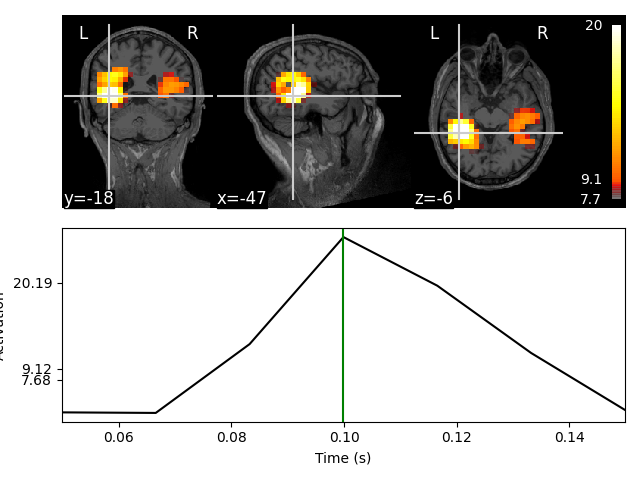
Out:
Showing: t = 0.100 s, (-47.3, -19.0, -6.3) mm, [4, 9, 10] vox, 5653 vertex
Using control points [ 7.67635542 9.11717401 20.19136023]
For this visualization, nilearn must be installed.
This visualization is interactive. Click on any of the anatomical slices
to explore the time series. Clicking on any time point will bring up the
corresponding anatomical map.
We could visualize the source estimate on a glass brain. Unlike the previous visualization, a glass brain does not show us one slice but what we would see if the brain was transparent like glass, and maximum intensity projection) is used:
stc.plot(src, subject='sample', subjects_dir=subjects_dir, mode='glass_brain')
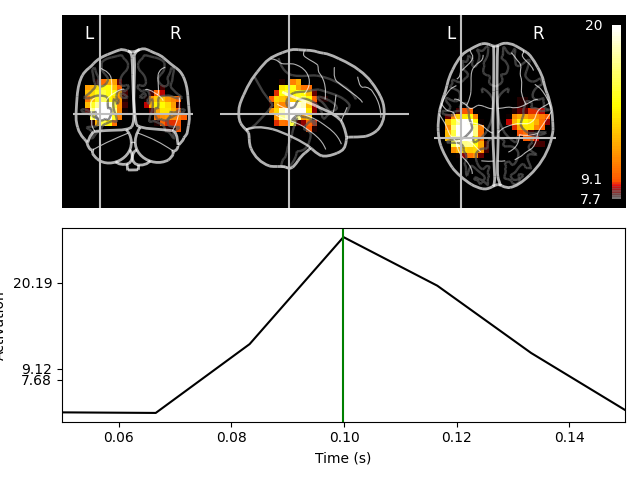
Out:
Transforming subject RAS (non-zero origin) -> MNI Talairach
1.022485 -0.008449 -0.036217 5.60 mm
0.071071 0.914866 0.406098 -19.82 mm
0.008756 -0.433700 1.028119 -1.55 mm
0.000000 0.000000 0.000000 1.00
Showing: t = 0.100 s, (-42.4, -43.1, -0.2) mm, [4, 9, 10] vox, 5653 vertex
Using control points [ 7.67635542 9.11717401 20.19136023]
You can also extract label time courses using volumetric atlases. Here we’ll
use the built-in aparc.a2009s+aseg.mgz:
fname_aseg = op.join(subjects_dir, 'sample', 'mri', 'aparc.a2009s+aseg.mgz')
label_names = mne.get_volume_labels_from_aseg(fname_aseg)
label_tc = stc.extract_label_time_course(
fname_aseg, src=src, trans=mri_head_t)
lidx, tidx = np.unravel_index(np.argmax(label_tc), label_tc.shape)
fig, ax = plt.subplots(1)
ax.plot(stc.times, label_tc.T, 'k', lw=1., alpha=0.5)
xy = np.array([stc.times[tidx], label_tc[lidx, tidx]])
xytext = xy + [0.01, 1]
ax.annotate(
label_names[lidx], xy, xytext, arrowprops=dict(arrowstyle='->'), color='r')
ax.set(xlim=stc.times[[0, -1]], xlabel='Time (s)', ylabel='Activation')
for key in ('right', 'top'):
ax.spines[key].set_visible(False)
fig.tight_layout()
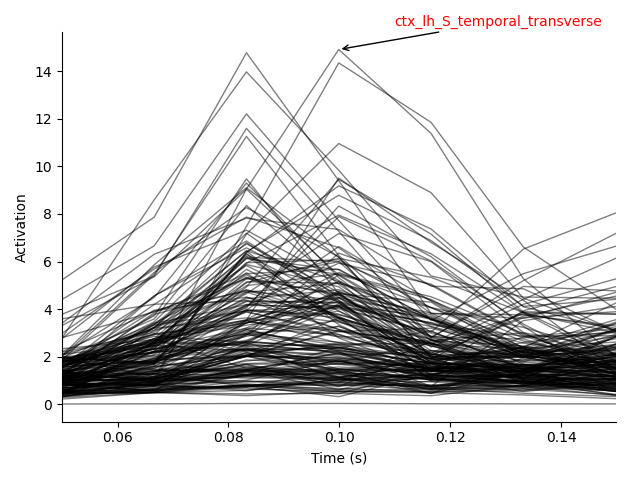
Out:
Reading atlas /home/circleci/mne_data/MNE-sample-data/subjects/sample/mri/aparc.a2009s+aseg.mgz
194/194 atlas regions had at least one vertex in the source space
Extracting time courses for 194 labels (mode: mean)
Vector Source Estimates¶
If we choose to use pick_ori='vector' in
apply_inverse
fname_inv = data_path + '/MEG/sample/sample_audvis-meg-oct-6-meg-inv.fif'
inv = read_inverse_operator(fname_inv)
stc = apply_inverse(evoked, inv, lambda2, 'dSPM', pick_ori='vector')
brain = stc.plot(subject='sample', subjects_dir=subjects_dir,
initial_time=initial_time)
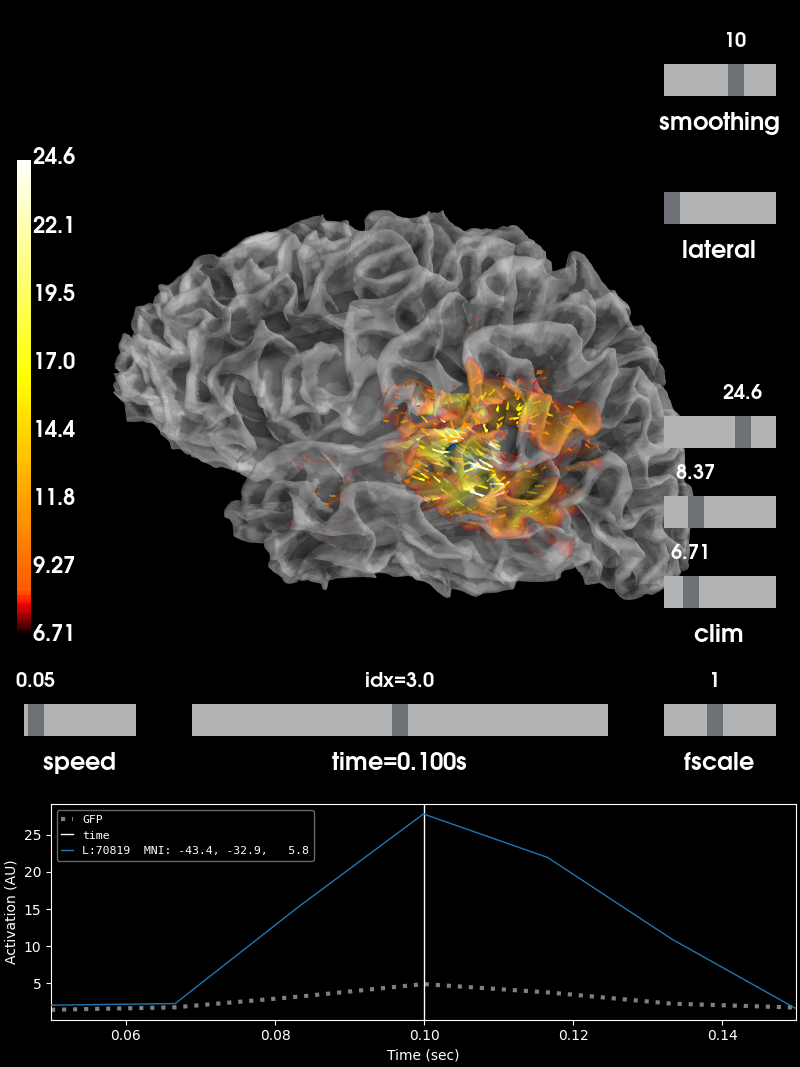
Out:
Reading inverse operator decomposition from /home/circleci/mne_data/MNE-sample-data/MEG/sample/sample_audvis-meg-oct-6-meg-inv.fif...
Reading inverse operator info...
[done]
Reading inverse operator decomposition...
[done]
305 x 305 full covariance (kind = 1) found.
Read a total of 4 projection items:
PCA-v1 (1 x 102) active
PCA-v2 (1 x 102) active
PCA-v3 (1 x 102) active
Average EEG reference (1 x 60) active
Noise covariance matrix read.
22494 x 22494 diagonal covariance (kind = 2) found.
Source covariance matrix read.
22494 x 22494 diagonal covariance (kind = 6) found.
Orientation priors read.
22494 x 22494 diagonal covariance (kind = 5) found.
Depth priors read.
Did not find the desired covariance matrix (kind = 3)
Reading a source space...
Computing patch statistics...
Patch information added...
Distance information added...
[done]
Reading a source space...
Computing patch statistics...
Patch information added...
Distance information added...
[done]
2 source spaces read
Read a total of 4 projection items:
PCA-v1 (1 x 102) active
PCA-v2 (1 x 102) active
PCA-v3 (1 x 102) active
Average EEG reference (1 x 60) active
Source spaces transformed to the inverse solution coordinate frame
Preparing the inverse operator for use...
Scaled noise and source covariance from nave = 1 to nave = 55
Created the regularized inverter
Created an SSP operator (subspace dimension = 3)
Created the whitener using a noise covariance matrix with rank 302 (3 small eigenvalues omitted)
Computing noise-normalization factors (dSPM)...
[done]
Applying inverse operator to "Left Auditory"...
Picked 305 channels from the data
Computing inverse...
Eigenleads need to be weighted ...
Computing residual...
Explained 77.5% variance
dSPM...
[done]
Using control points [ 6.70708526 8.36619556 24.64056812]
Dipole fits¶
For computing a dipole fit, we need to load the noise covariance, the BEM solution, and the coregistration transformation files. Note that for the other methods, these were already used to generate the inverse operator.
fname_cov = os.path.join(data_path, 'MEG', 'sample', 'sample_audvis-cov.fif')
fname_bem = os.path.join(subjects_dir, 'sample', 'bem',
'sample-5120-bem-sol.fif')
fname_trans = os.path.join(data_path, 'MEG', 'sample',
'sample_audvis_raw-trans.fif')
Dipoles are fit independently for each time point, so let us crop our time series to visualize the dipole fit for the time point of interest.
evoked.crop(0.1, 0.1)
dip = mne.fit_dipole(evoked, fname_cov, fname_bem, fname_trans)[0]
Out:
MRI transform : /home/circleci/mne_data/MNE-sample-data/MEG/sample/sample_audvis_raw-trans.fif
Head origin : -4.3 18.4 67.0 mm rad = 71.8 mm.
Guess grid : 20.0 mm
Guess mindist : 5.0 mm
Guess exclude : 20.0 mm
Using standard MEG coil definitions.
Noise covariance : /home/circleci/mne_data/MNE-sample-data/MEG/sample/sample_audvis-cov.fif
Coordinate transformation: MRI (surface RAS) -> head
0.999310 0.009985 -0.035787 -3.17 mm
0.012759 0.812405 0.582954 6.86 mm
0.034894 -0.583008 0.811716 28.88 mm
0.000000 0.000000 0.000000 1.00
Coordinate transformation: MEG device -> head
0.991420 -0.039936 -0.124467 -6.13 mm
0.060661 0.984012 0.167456 0.06 mm
0.115790 -0.173570 0.977991 64.74 mm
0.000000 0.000000 0.000000 1.00
0 bad channels total
Read 305 MEG channels from info
99 coil definitions read
Coordinate transformation: MEG device -> head
0.991420 -0.039936 -0.124467 -6.13 mm
0.060661 0.984012 0.167456 0.06 mm
0.115790 -0.173570 0.977991 64.74 mm
0.000000 0.000000 0.000000 1.00
MEG coil definitions created in head coordinates.
Decomposing the sensor noise covariance matrix...
Created an SSP operator (subspace dimension = 3)
Computing rank from covariance with rank=None
Using tolerance 3.3e-13 (2.2e-16 eps * 305 dim * 4.8 max singular value)
Estimated rank (mag + grad): 302
MEG: rank 302 computed from 305 data channels with 3 projectors
Setting small MEG eigenvalues to zero (without PCA)
Created the whitener using a noise covariance matrix with rank 302 (3 small eigenvalues omitted)
---- Computing the forward solution for the guesses...
Guess surface (inner skull) is in MRI (surface RAS) coordinates
Filtering (grid = 20 mm)...
Surface CM = ( 0.7 -10.0 44.3) mm
Surface fits inside a sphere with radius 91.8 mm
Surface extent:
x = -66.7 ... 68.8 mm
y = -88.0 ... 79.0 mm
z = -44.5 ... 105.8 mm
Grid extent:
x = -80.0 ... 80.0 mm
y = -100.0 ... 80.0 mm
z = -60.0 ... 120.0 mm
900 sources before omitting any.
396 sources after omitting infeasible sources not within 20.0 - 91.8 mm.
Source spaces are in MRI coordinates.
Checking that the sources are inside the surface and at least 5.0 mm away (will take a few...)
Skipping interior check for 42 sources that fit inside a sphere of radius 43.6 mm
Skipping solid angle check for 186 points using Qhull
195 source space points omitted because they are outside the inner skull surface.
45 source space points omitted because of the 5.0-mm distance limit.
156 sources remaining after excluding the sources outside the surface and less than 5.0 mm inside.
Go through all guess source locations...
[done 156 sources]
---- Fitted : 99.9 ms, distance to inner skull : 7.5945 mm
Projections have already been applied. Setting proj attribute to True.
1 time points fitted
Finally, we can visualize the dipole.
dip.plot_locations(fname_trans, 'sample', subjects_dir)
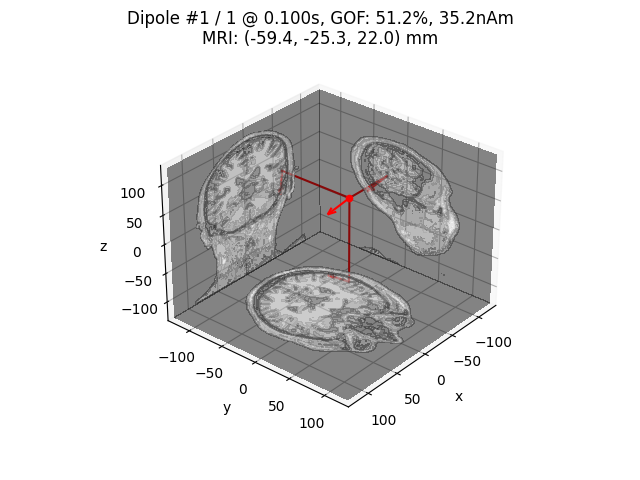
Total running time of the script: ( 1 minutes 12.195 seconds)
Estimated memory usage: 550 MB